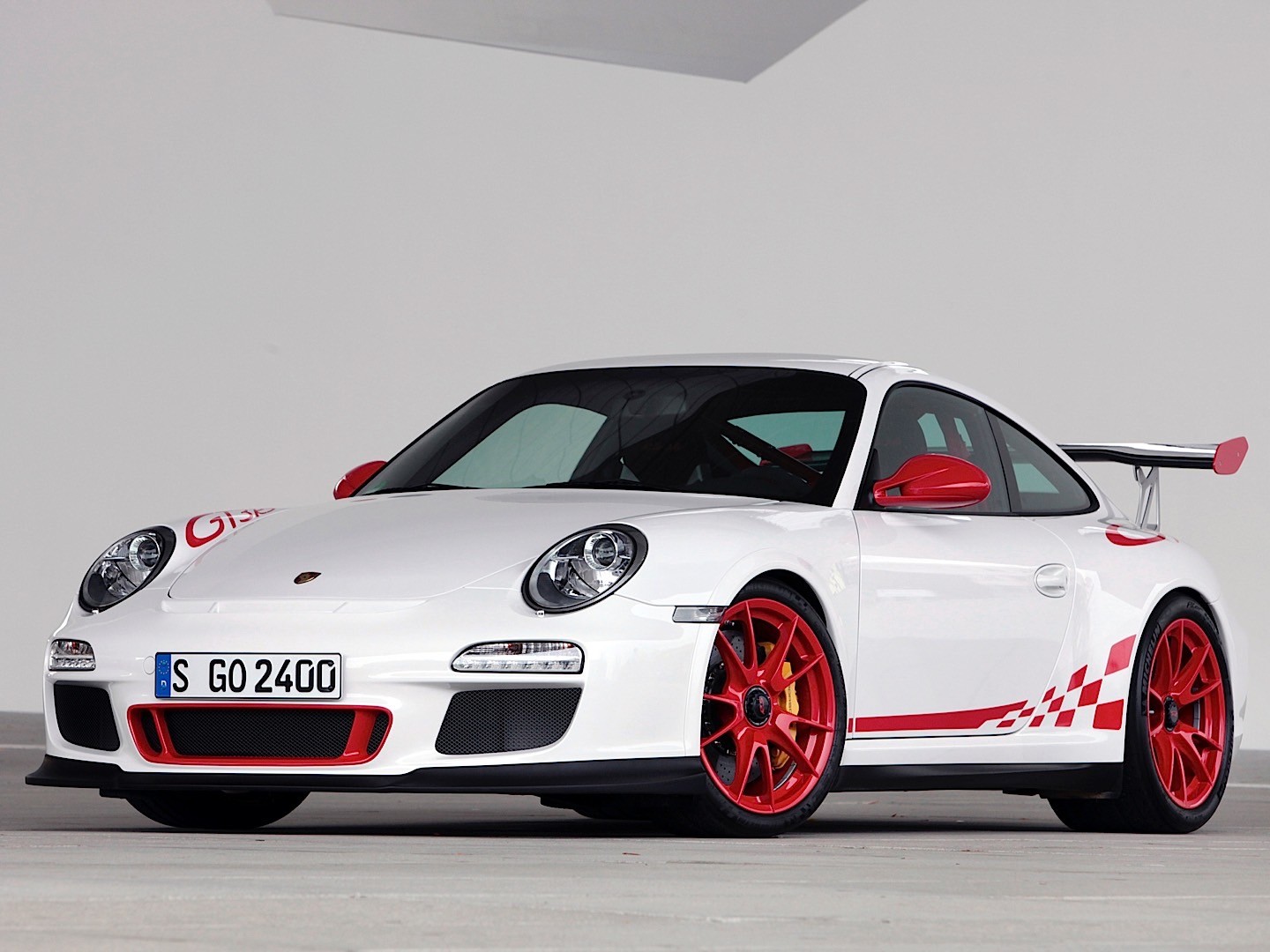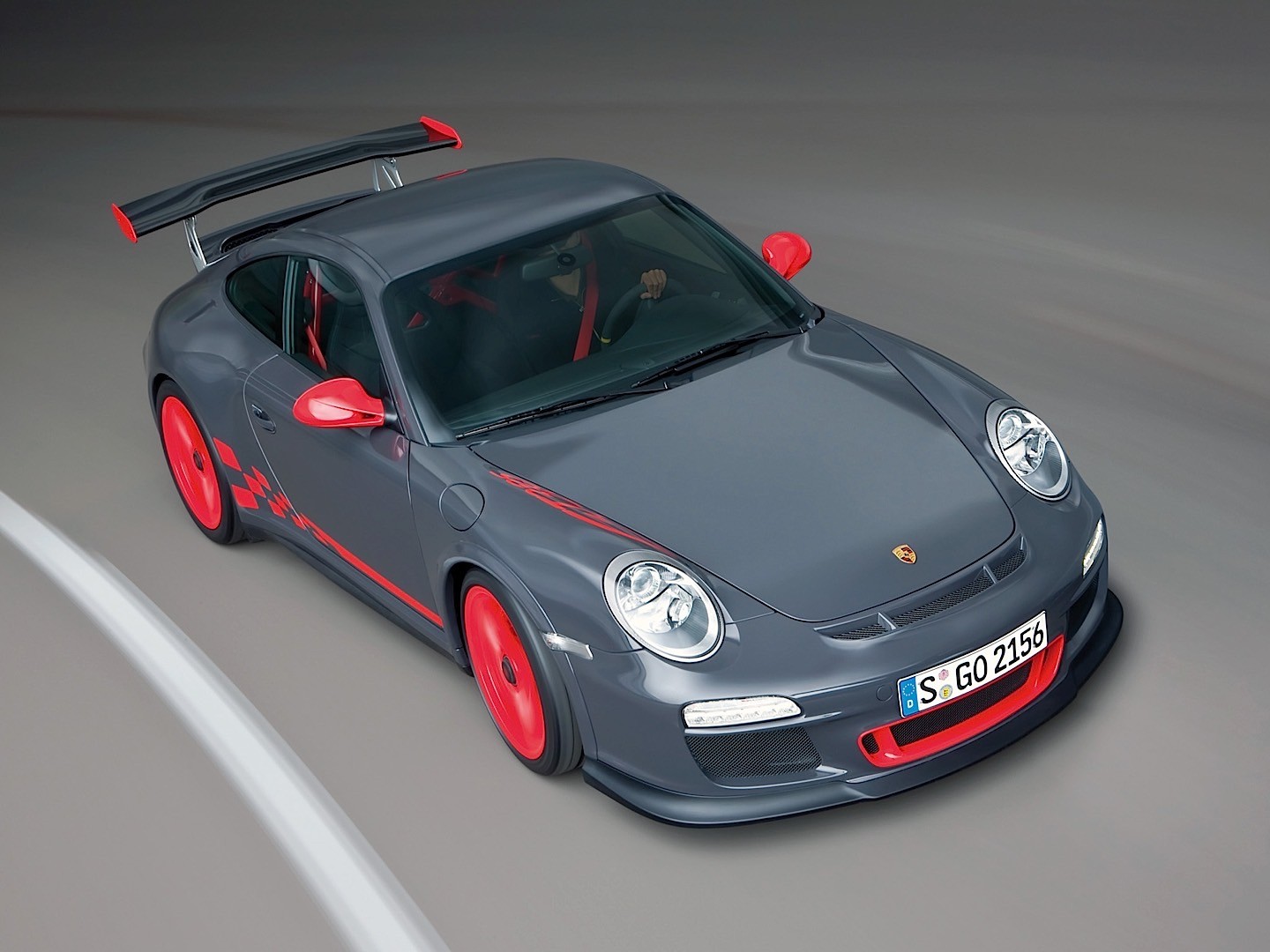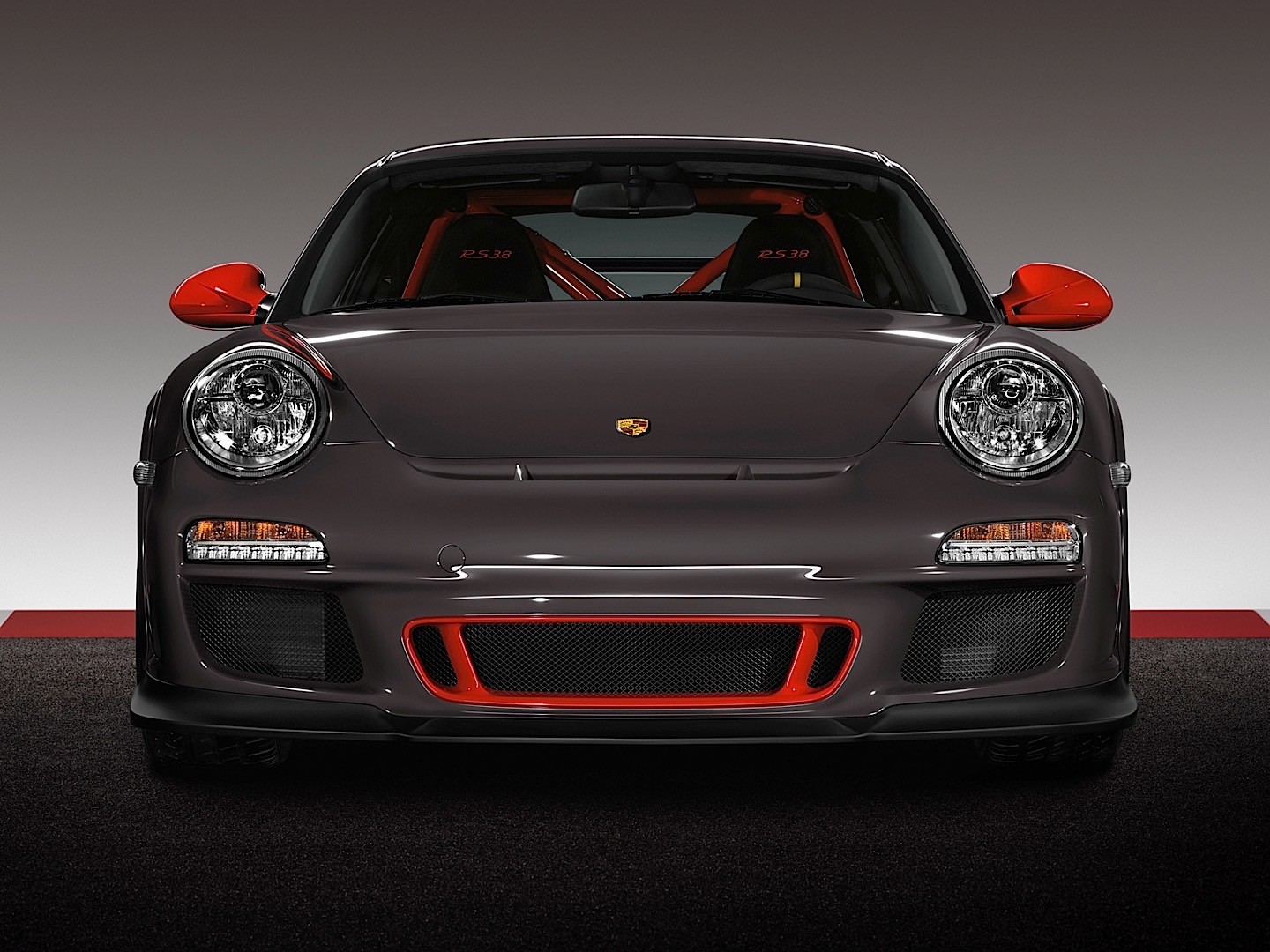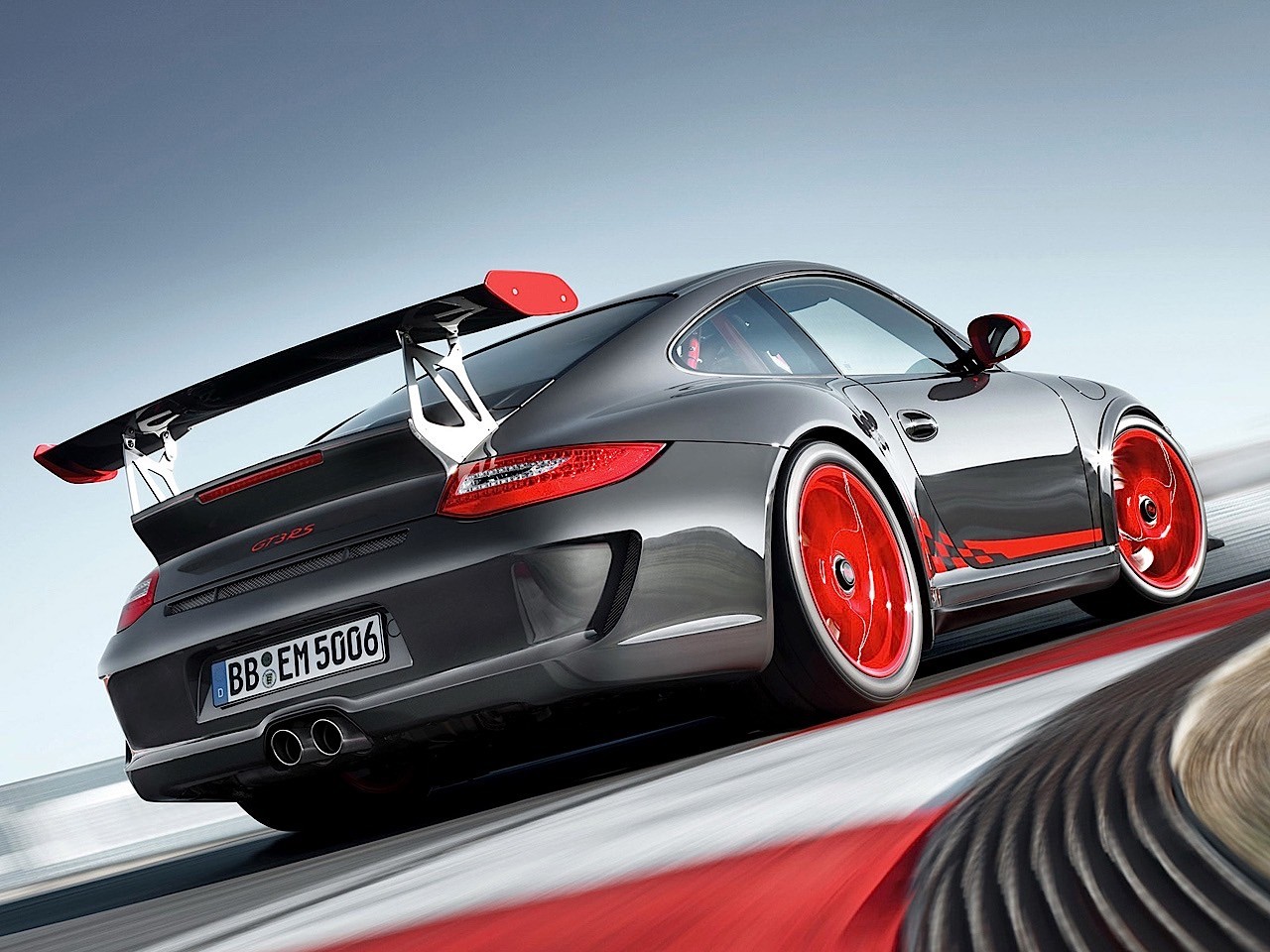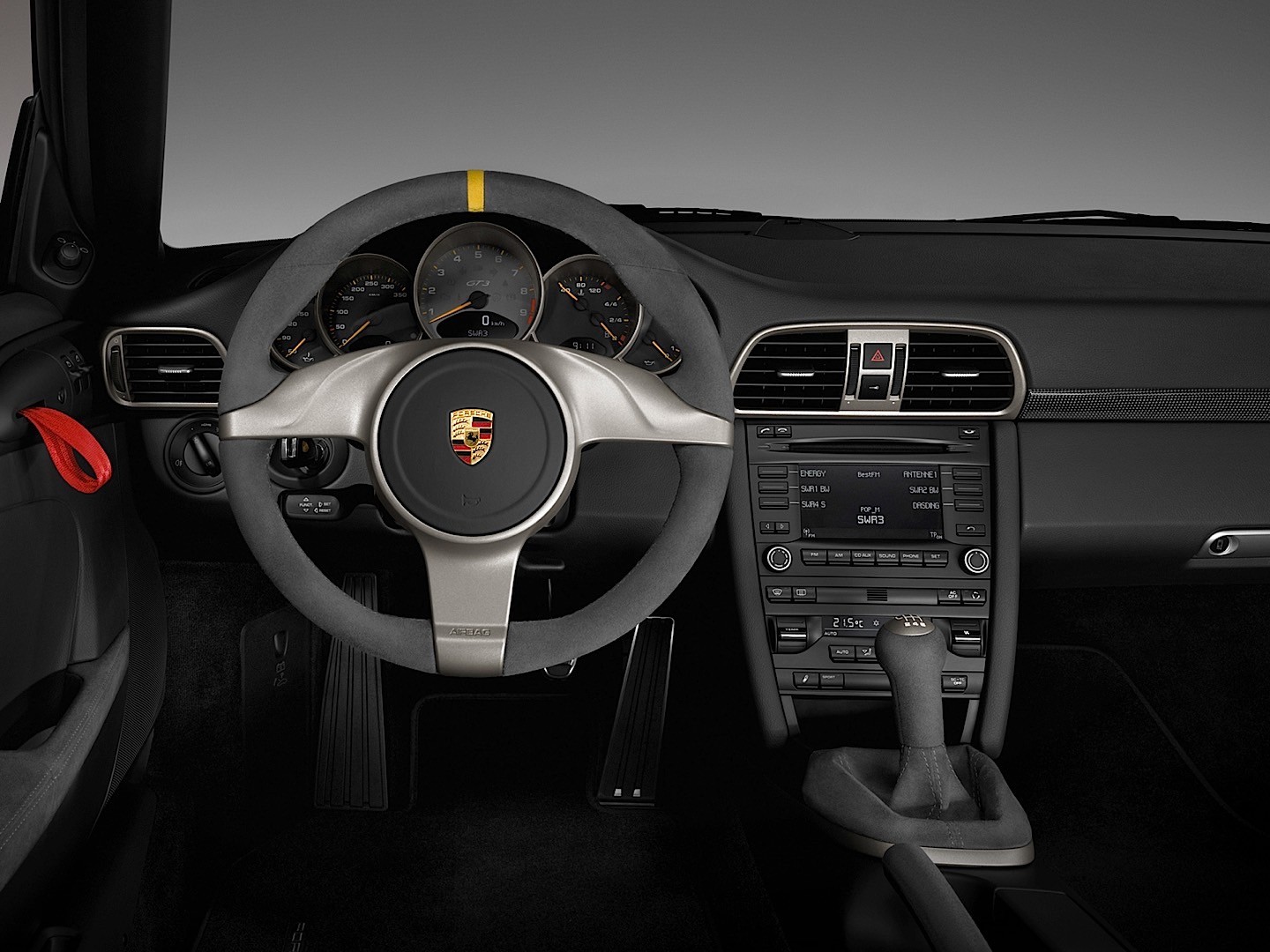(2010 – 2012) Porsche 911 GT3 RS 3.8 (997.2) – Ultimate Guide
The second generation 911 GT3 RS (known as 997.2 GT3 RS) received an additional 15 PS (11 kW; 15 hp) thanks to a new 3.8-litre flat-6 engine, bringing total power output up to 450 hp (336 kW; 450 hp). The only transmission offered was the six-speed manual. The car was not approved for competition in the United States by IMSA American LeMans. Grand-Am originally did not approve the car, but after performance issues (a Porsche team did not compete at the Indy Grand Prix of Alabama round), Grand-Am approved the second-generation car in April 2010. The RS was modified according to safety requirements, which included a larger roll cage and fire extinguisher.
Delivering even more engine power, lower weight and shorter transmission ratios, as well as upgraded body and suspension components than all previous GT3s, the 997.2 Porsche 911 GT3 RS sets the foundation for homologating the race version of the 911 GT3. The heart of the new, uncompromising GT3 RS is the power unit. Like the engine featured in the 911 GT3, the naturally-aspirated RS power unit now displaces 3.8 liters and delivers even more power, while revving up even faster to its 8500 rpm redline. It now delivers 450 horsepower, 15 more horsepower than its 997.2 911 GT3 counterpart. Even with a specific output of more than 118 hp per liter from the six-cylinder boxer engine, the power unit in the new GT3 RS remains fully suitable for everyday use.
Like in the 997.2 GT3, the only available transmission is a six-speed manual gearbox. The six-speed manual gearbox optimized for short gearshift travel, low weight and high efficiency. To enhance the level of performance throughout the entire range of engine and road speed, the transmission comes with shorter ratios than found in the 911 GT3, deliberately conceding an even higher potential top track speed.
Dynamic engine mounts are standard and serve to improve the car’s handling to an even higher level. Depending on driving conditions, the mounts change in their stiffness and damping effect, improving the connection between the engine and the body when driving under very lively conditions, yet allow for more comfortable conditions during everyday street use.
Porsche is also introducing another new option in 2010 for the GT3 RS, a lithium-ion battery. Delivered with the car and, when replacing the conventional lead-acid battery, it reduces the weight by more than 10 kg or 22 lb and is mainly intended for the track. To further improve its sporting behavior, the new 911 GT3 RS comes with a purpose-built and specially set up PASM suspension, a wider front and rear track and corresponding bodywork.
Front and rear tracks are widened by 1.7 and 1.0 inches, respectively, with 19-inch wheels wrapped in sticky 245/35 Michelin Pilot Sport Cup tires up front and honking 325/30s in the rear. The wider hips from all-wheel-drive 911s cover the rear rubber, while the front fenders get subtle wheel-arch extensions. Like all RS cars, it also gets a massive rear wing made of carbon fiber and supported by aluminum struts that provides ample gains in downforce.
Other RS-specific bits include a titanium rear muffler and exhaust tips that together save 13 pounds—and will no doubt contribute to a spine-tingling scream from the flat-six as it nears its 8500-rpm redline. A lithium-ion battery will save an additional 20 pounds or so, according to Porsche. Altogether, the RS weighs just 3020 pounds, making it more than 50 pounds lighter than the GT3. Porsche says the result of the weight savings, additional power, and improved gearing will be a 0-to-60-mph sprint in just 3.8 seconds and 100 mph in 8.1 seconds. Top speed is 193 mph and the quarter mile is done with in only 11.8 seconds. It is on track however that the real performance is shown. At the time of it’s launch in 2010, the 997.2 GT3RS held the Nürburgring lap record time of 7:18.
This most-special 911 will continue the RS tradition of wild paint schemes, and will be available in two standard hues—Carrara (yeah, that’s really how Porsche spells the color) White and Aqua Blue Metallic—or Grey Black at added cost. Each color is paired with one of two available contrasting graphic colors, either Guards Red or White Gold Metallic.
Pictures
Press Release
The Porsche 911 GT3 RS is the last and highest stage of development of the 911 for road use before moving on to genuine racing cars for circuit events. Offering even more power, lower weight, shorter transmission ratios as well as body and suspension elements upgraded to an even higher standard, the new 911 GT3 RS has been developed as the homologation model for the racing version of the 911 GT3 and therefore has everything it takes for further success on the trace tack.
The new car therefore continues the series of uncompromisingly sporting derivatives of the 911 homologated for road use and, with its purist character, addresses above all the driver with motorsport ambitions, as the car’s specifications clearly prove: 3.8-litre six-cylinder horizontally-opposed power unit delivering 450 bhp (331 kW); six-speed manual gearbox; acceleration from 0-100 km/h in 4.0 seconds; top speed 310 km/h (192 mph); DIN unladen weight 1,370 kg (3,021 lb); fuel consumption in the NEDC driving cycle 13.2 ltr/100 km (equal to 21.4 mpg imp).
At very first sight the new Porsche 911 GT3 RS clearly demonstrates its close connection with motorsport. This is borne out in particular by the car’s low suspension, central bolts on the wheels, the new, large rear wing made of carbon-fibre and with aluminium supports on each side, the purpose-built front and rear sections as well as the dual tailpipe in the middle made of top-quality titanium on the new 911 GT3 RS, just like the entire rear muffler.
The power unit of the Porsche 911 GT3 RS is based on the proven components already featured in the current 911 GT3 – including the increase in engine capacity over the former model from 3.6 to 3.8 litres. The most important highlights are dry sump lubrication with an external engine oil tank, titanium connecting rods, upgraded VarioCam valve control with small cup tappets able to run at high engine speeds, a variable intake system with two resonance flaps, and the sports exhaust system with reduced counter-pressure.
The increase in power over the 911 GT3 by 15 bhp is the result of the improved air filter and intake manifold reducing flow resistance by approximately 20 per cent.
With its high-speed engine concept for maximum speeds of up to 8,500 rpm, as well as further modifications for extra power, the new 911 GT3 RS, like its predecessor, is one of the absolute leaders in its segment. Indeed, output per litre of more than 118 bhp comes right at the top among all naturally-aspirated power units ever built for a car homologated for the road.
High-speed power unit even lighter and more agile than before
The six-cylinder power unit has been optimised consistently and without compromises for agility and free-revving qualities. One of the features used for this purpose is a single-mass flywheel allowing the engine to rev up faster and therefore offering an even greater potential for fast acceleration. Compared with the former model, the single-mass flywheel on the Porsche 911 GT3 RS is approximately 1.4 kilos lighter, therefore offering a reduction in weight of more than 8 kg or 17.5 lb versus the two-mass flywheel on the 911 GT3. Short transmission ratios further enhance the actual performance of the car.
Like on the current 911 GT3, the driver is able to further increase the power of the highper formance engine also in the new Porsche 911 GT3 RS. This he does by pressing the Sports Button featured as standard in the centre console, increasing torque at medium engine speeds, as on the 911 GT3, by up to 35 Nm/26 lb-ft. Maximum torque of 430 Nm/317 lb-ft at 6,750 rpm, however, remains unchanged.
The increase in torque is achieved by a further reduction of exhaust gas counter-pressure in the sports exhaust system and the further improvement of the charge cycle provided in this way.
Power transmission optimised consistently for supreme performance
The new 911 GT3 RS comes as standard with a manual six-speed gearbox optimised for short gear travel, low weight and high efficiency. To improve performance to an even higher level, gears 1 – 5 come with a transmission ratio about 11 per cent shorter than on the 911 GT3, providing an even better ongoing flow of power after shifting gears and offering new potential for even faster acceleration.
The transmission ratio in sixth gear is 5 per cent shorter, deliberately foregoing an even higher top speed in the interest of maximum racetrack performance.
The power unit of the new Porsche 911 GT3 RS is supplemented by a mechanical rear axle lock generating an asymmetric effect, featured as standard like on the former model and the current 911 GT3. Locking action is 28 per cent under power and 40 per cent in overrun, ensuring high traction on varying road surfaces as well as precise behaviour in bends, especially under load change, all the way up to the very limit.
Dynamic engine mounts featured as standard also serve to improve the car’s driving dynamics, changing their stiffness and damping effect as a result of driving conditions and improving the connection between the power unit and the body whenever the driver prefers a particularly dynamic style of motoring.
To ensure an even higher standard of sporting performance, the 911 new GT3 RS comes with an appropriately set-up PASM suspension, extra-large brakes with aluminium brake covers, wheels with central bolts and wider track for the first time not only at the rear, but also at the front. Accordingly, the body of the new Porsche 911 GT3 RS is not only wider on the rear axle, but also comes with additional wheel arch fairings on the front wheels, which now measure nine inches in width and run on 245/35 ZR 19 sports tyres, while the wheels at the rear are twelve inches wide and come on 325/30 ZR 19 sports tyres.
First 911 GT3 RS with Porsche Stability Management suitable for racing
Another new feature on the 911 GT3 RS is PSM Porsche Stability Management, in this case in a special, extra-sporting version. As opposed to Traction Control featured on the former model, a system serving to stabilise the car when accelerating, PSM offers a much higher standard of active safety, while, through its specific set-up, nevertheless also meets the dynamic requirements of the extremely sporting driver. Indeed, its control algorithm completely switching off when desired in two stages has been developed specifically for racing on the track.
New: lithium-ion battery to save weight
By tradition, supreme performance as a result of low weight has always been of particularly great significance on the 911 GT3. Precisely this is why the current 911 GT3 comes with features such as the bootlid and doors made of aluminium, providing a good starting point for weight reduction.
Despite its even wider body, the new Porsche 911 GT3 RS is 25 kilos or 55 lb lighter than the 911 GT3, weighing just 1,370 kg or 3,021 lb. This significant reduction of weight is achieved, among other things, by lighter components such as the titanium exhaust system, the singlemass flywheel, the rear window made of a special synthetic material, lightweight door panels, as well as the centre panel at the rear and the rear wing itself made of composite materials.
Starting in 2010, Porsche will furthermore be introducing yet another new option, a lithiumion battery coming together with the car specifically for use on the race track. Subsequently fitted instead of the conventional lead battery, this reduces the overall weight of the car by more than 10 kg or 22 lb.
Improved aerodynamics for additional downforce
Yet a further highlight in developing the new Porsche 911 GT3 RS was the car’s aerodynamics, particularly the generation of downforce. Thanks to the larger rear wing, downforce on the rear axle is even greater than on the 911 GT3, an effect supplemented by an additional spoiler on the front lip of the new 911 GT3 RS. This generates higher downforce also on the front axle to keep the car in perfect aerodynamic balance, the new Porsche 911 GT3 RS thus offering an even greater potential for fast lateral acceleration and even higher speeds on winding circuits.
Specifically designed and created for motorsport, the interior of the new 911 GT3 RS features alcantara elements and is even more purist in style than the interior of the GT3. Typical features are the lightweight door panels with traditional door opening straps, a special RS sports steering wheel, and various carbon components. The cupholder is dropped for rea sons of weight.
Again in the interest of minimum weight, the RS is also available without air conditioning and a radio. The Clubsport Package already well-known from the GT3, made up of a rollbar, fire extinguisher, six-point seat belt and flame-retardant seat covers bearing the RS 3.8 logo, is standard on the Porsche 911 GT3 RS. Additional features available on request are a pneu matic lift system for the front axle raising up the front end of the car by approximately 30 millimetres or 1.2 inches or a 90-litre (19.8 imp gals) long-distance fuel tank.
Quite generally, the range of customisation options has been significantly increased over the former model, with light halogen headlights or dynamic bending lights as well as PCM Porsche Communication Management complete with a touchscreen and the integrated HomeLink® garage gate opener all available as options.





